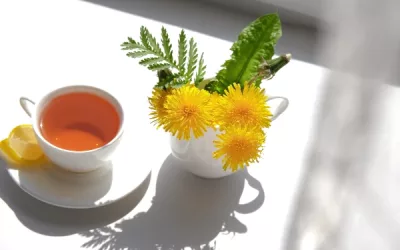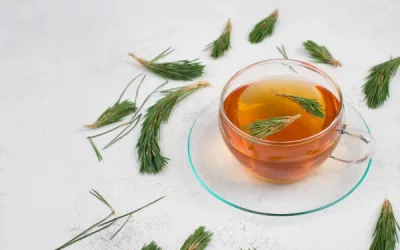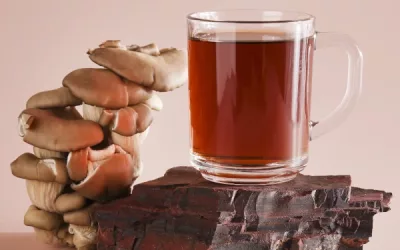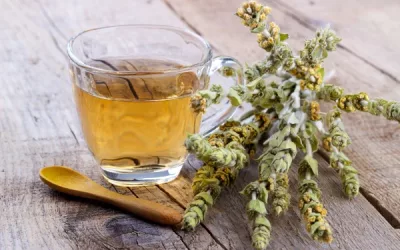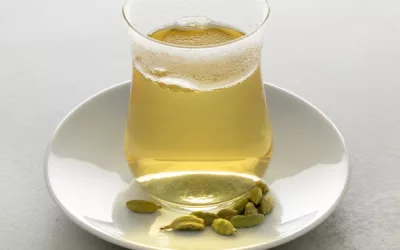Did you know that kava tea has been consumed for centuries across the South Pacific for its calming effects? With a rising interest in herbal remedies, kava tea stands out not only for its potential health benefits but also for its rich cultural significance. Understanding its properties is essential for anyone curious about natural alternatives to manage stress and anxiety. This article will explore kava tea’s benefits, preparation methods, side effects, purchasing options, and safety considerations to ensure you make informed choices.
Table of Content
What is Kava tea?
Kava tea is a beverage made from the root of the kava plant (Piper methysticum), which is native to the Pacific Islands. It has been traditionally used for centuries in Pacific Island cultures for its calming and sedative effects.
Here’s a quick overview of kava tea:
Key Components:
- Kavalactones: The active compounds in kava root that are responsible for its relaxing and anxiety-reducing effects.
Common Uses:
- Relaxation: Kava tea is often used to reduce stress and promote relaxation.
- Anxiety relief: It’s used by some to help alleviate mild to moderate anxiety.
- Sleep aid: Some people drink kava tea to help with sleep issues due to its sedative properties.
Effects:
- Calming: Kava tea induces a sense of relaxation without causing drowsiness, although larger amounts may have a more sedative effect.
- Muscle relaxation: It can have muscle-relaxing properties.
Potential Side Effects:
- Liver toxicity: Prolonged or excessive use of kava has been linked to liver damage in some cases. It’s important to use it in moderation and consult a healthcare provider if you have liver issues.
- Drowsiness: High doses can cause excessive drowsiness or impair motor function.
- Interactions with medications: Kava can interact with certain medications, particularly those affecting the central nervous system.
Legal Status:
- Kava’s legal status varies by country. Some countries restrict its sale due to concerns about liver toxicity, while in others, it’s available as a supplement or tea.
Kava tea is popular in herbal medicine circles for its calming effects, but it’s important to use it responsibly.
In the late 18th century, Captain James Cook and his crew encountered the people of the Pacific Islands who introduced them to kava. Cook observed the ceremonial use of kava, noting its significance in fostering social cohesion and relaxation among the islanders.
The exchange of kava became a mark of hospitality and peace, leaving a lasting impression on Cook and his crew.
How is kava tea prepared?
Kava tea, a drink made from the roots of the kava plant, has been a staple in Pacific Island traditions for centuries. It’s renowned for its calming properties and ability to ease anxiety. Preparing kava tea can be quite an intriguing process, with traditional methods deeply rooted in cultural practices and modern approaches catering to convenience.
To best illustrate the various ways to prepare kava tea, I have created a table that outlines different preparation methods, the necessary ingredients, steps involved, effects, and notes. This should help you understand and choose the method that suits your needs.
| Method | Ingredients | Preparation Steps | Effects | Notes |
|---|---|---|---|---|
| Traditional | Kava root powder, water | 1. Place kava powder in a muslin cloth. 2. Submerge in water. 3. Knead for 10-15 minutes. |
Stronger relaxation and mild euphoria. | Time-consuming, requires practice. |
| Instant Kava Mix | Instant kava powder, water | 1. Mix instant kava powder with water. 2. Stir until dissolved. |
Quick relaxation effect. | Convenient but may contain additives. |
| Blender Method | Kava root powder, water | 1. Blend kava powder with water. 2. Strain using a muslin cloth or fine strainer. |
Moderate relaxation and mild euphoria. | Faster than traditional, less effective. |
| Kava Tea Bags | Kava tea bags, hot water | 1. Steep kava tea bag in hot water for 10-15 minutes. | Mild relaxation. | Easy to prepare, perfect for beginners. |
| Cold Brew Kava | Kava root powder, water | 1. Mix kava powder with cold water. 2. Let sit in the refrigerator for 8-12 hours. 3. Strain. |
Mild to moderate relaxation. | Requires planning ahead. |
| Kava Extract Tincture | Kava extract, water or juice | 1. Measure the desired amount of kava extract. 2. Mix with water or juice. |
Immediate, potent relaxation. | Concentrated, use with caution. |
| AluBall Method | Kava root powder, AluBall shaker, water | 1. Place kava powder in AluBall. 2. Add water to shaker. 3. Shake for 2-3 minutes. |
Moderate relaxation and mild euphoria. | Quick and easy, perfect for busy days. |
Traditional preparation method
Traditional preparation involves kneading kava root powder in water, often using a muslin cloth. This method ensures the highest potency and is deeply rooted in Pacific Islander customs. To prepare:
- Place kava powder in a muslin cloth.
- Submerge in a bowl of water.
- Knead the cloth for about 10-15 minutes.
- Strain the mixture and serve.
This method produces a strong, earthy-flavoured tea that offers significant relaxation and mild euphoria. It might take a bit of practice, but the results are worth it.
Modern preparation methods
Modern methods cater to the need for convenience and efficiency. Options like instant kava mix, kava tea bags, and the AluBall shaker simplify the process without compromising much on the effects.
- Instant Kava Mix:
- Mix instant powder with water.
- Stir until dissolved.
- Quick and convenient for instant relaxation.
- Kava Tea Bags:
- Steep tea bags in hot water for 10-15 minutes.
- Ideal for beginners and those short on time.
- AluBall Method:
- Place kava powder in the AluBall.
- Add water to the shaker.
- Shake for 2-3 minutes.
- Perfect for a quick preparation with good results.
Another popular modern method is using a blender. Blend kava powder with water, then strain the mixture. This saves time compared to traditional kneading but still provides a decent potency.
Cold brew kava is another alternative that requires mixing kava powder with cold water and letting it sit in the refrigerator for 8-12 hours. Lastly, using kava extract tinctures gives you a potent, immediate dose of kava with minimal preparation.
In ancient times, the people of Fiji considered kava to be a sacred plant. They often used kava during important ceremonies, such as marriages and peace negotiations. Legend has it that the plant was a gift from the gods, and its preparation was a ritual that required precision and respect.
The villagers would gather around a large bowl, and the most skilled individual would lead the kneading process, ensuring the perfect consistency and potency. This tradition not only highlighted the plant’s importance but also brought the community together, fostering unity and shared purpose.
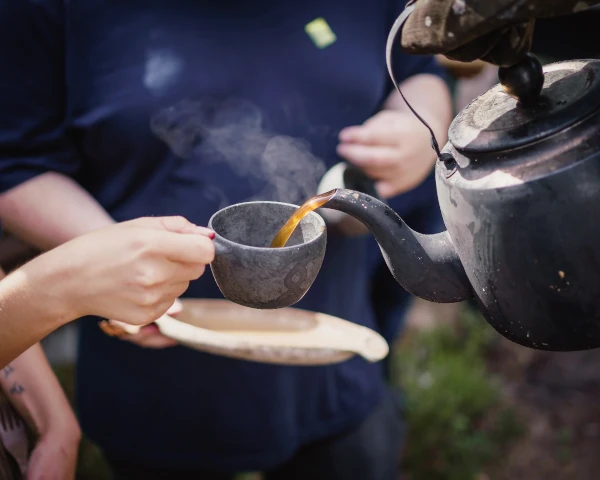
What are the potential side effects of drinking kava tea?
Kava tea, the murky brew revered in the South Pacific, might promise a state of relaxation akin to a lazy day under a palm tree. But hold your coconuts! This herbal drink isn’t all sunshine and good vibes. It comes with a handful of potential side effects that could make you rethink that second cup. Let’s dive into the whirlpool of kava’s darker side and see what risks lurk below the surface.
Before you get your flip-flops in a twist, know this: the main concerns with kava tea relate to liver toxicity, medication interactions, psychological effects, and dosage dilemmas. Oh, and consumer safety can’t be ignored either. It’s a wild ride, but stick with me; we’ll make sense of it all while keeping it entertaining.
What are the common side effects of kava tea?
Alright, let’s talk turkey—or rather, kava root shavings. When it comes to kava tea, the potential side effects might not be a walk in the park. Here’s what could happen:
- Liver toxicity: Your liver might not be throwing a kava party. Prolonged use can mess with liver function, leading to potentially severe liver damage.
- Medication interactions: Mixing kava with other medications is like inviting a bull to a china shop. It can increase the risk of adverse effects or reduce the efficacy of certain drugs.
- Psychological effects: Feeling too good to be true? High doses of kava can lead to sedation, confusion, and in severe cases, hallucinations.
- Gastrointestinal issues: Your stomach might protest with nausea, upset, or diarrhea.
- Skin issues: Ever wanted rough, scaly skin? No? Well, chronic use of kava can result in a condition called kava dermopathy.
In short, while kava might send you to relaxation city, the side effects can make that trip a bumpy one.
How can one mitigate the risks of kava tea consumption?
If you’re set on sipping this controversial brew, there are ways to dodge the worst-case scenarios. Here’s what you can do:
- Moderate consumption: Keep it cool and avoid drinking kava every day. Occasional use is safer.
- Choose quality products: Go for reputable brands that provide information on the concentration of kavalactones and ensure the root used is noble kava, not tudei.
- Consult a healthcare professional: Get the lowdown from your doctor, especially if you’re on other medications or have existing health issues.
- Watch your dosage: Don’t go overboard. Stick to the recommended dosage; more isn’t merrier here.
- Stay hydrated: Drink plenty of water to help flush out toxins and support liver function.
By taking these steps, you can enjoy your kava tea without turning into a cautionary tale.
Are there specific populations that should avoid kava tea?
Not everyone should be jumping on the kava bandwagon. Some people need to steer clear of this herbal drink. Here’s who should put the teapot down:
- Pregnant or breastfeeding women: The effects of kava on pregnancy and infants aren’t well-known, so it’s safer to avoid it.
- Individuals with liver conditions: If your liver isn’t in tip-top shape, kava could make things worse.
- People with mental health disorders: Kava’s psychological effects can exacerbate certain conditions, so it’s best avoided.
- Those on medications: If you’re taking medication, especially for anxiety, depression, or liver issues, kava could interact in harmful ways.
- Children and adolescents: Their developing bodies aren’t ready to handle kava’s potential side effects.
In essence, if you fall into one of these categories, kava tea is a no-go zone.
Back in the late 1990s, Germany faced a health crisis linked to kava. Reports of severe liver damage caused an uproar, leading to the suspension of kava sales. The German Commission E, responsible for evaluating herbal remedies, yanked kava off the market quicker than you can say “liver failure”. It turned out that the kava products in question were made using stem peelings and leaves—parts of the plant that are more toxic than the roots traditionally used for kava drinks. This kerfuffle led to stricter regulations and quality controls in Europe. A classic case of lessons learned the hard way.
So, as you brew your next cup of kava tea, remember: knowledge is power, and a bit of caution can keep your wellness journey on the right path. Cheers!
Is kava tea safe to drink every day?
Ah, the age-old question that keeps herbal enthusiasts awake at night. Is it wise to sip kava tea every day? Let’s cut through the haze of ambiguity and dive straight into the nitty-gritty.
Drinking kava tea daily can be a bit like walking a tightrope. On one hand, kava’s all-natural, sourced from the root of a Pacific island plant, and packed with kavalactones which help in feeling relaxed without making you loopy. On the other hand, overindulgence can send you on a one-way trip to hepatotoxicity town — no fun.
Now, health experts and herbal aficionados suggest that moderation is key. Think of it like enjoying chocolate cake. Delightful occasionally, disastrous if consumed for breakfast, lunch, and dinner. Let’s expand on that.
What do health experts say about daily kava consumption?
Experts generally advise caution when it comes to daily kava tea consumption. Why? The liver, that’s why. Kava has been linked to liver toxicity, which has caused quite a stir.
- Long-term health: Chronic use can lead to hepatotoxicity; the liver isn’t a fan of constant kava.
- Dependency: Not an instant addiction, but over time, your body may hanker for that extra sip to unlock its mellow magic.
- Guidelines: WHO and some countries have flagged kava, limiting its sale; reading the fine print on health guidelines is crucial.
- Experts’ advice: They often suggest kava be consumed intermittently rather than daily.
Remember when Isaac Newton took a hit to the head and discovered gravity? Experts’ opinions on kava tea should be treated with similar gravity.
How much kava tea is considered safe?
Ah, the golden question. How do you relish your kava without falling into the overboard abyss?
- Dosage: Aim for 250 mg of kavalactones per day; that’s roughly 2-3 cups but check those labels.
- Tolerance: Your body, your rules. Ease into it and sense how your body responds.
- Rest days: Just like workout routines suggest rest days, throw in some kava-free days.
- Avoid chugging: Mind you, it’s not a protein shake; sip slowly.
- Consult a pro: Before making it a habit, chat with a healthcare provider.
Measuring isn’t about holding a beaker and fancy scales; it’s about mindful sipping, Sherlock.
What are the signs of overconsumption?
What’s the sound of kava alarms blaring? When should you put the teacup down and step away slowly?
- Liver issues: Yellowing of skin or eyes, intense itchiness; if you turn into a jaundiced pirate, there’s a problem.
- Digestive distress: Upset stomach, nausea, or belly ache. No one enjoys a turbulent gut.
- Mental fuzziness: Excess drowsiness or the inability to grasp simple concepts, like 2+2.
- Skin issues: Dermopathy, a kava-made skin condition, gives you that not-so-glamorous scaly skin.
- Emotional rollercoaster: Increased agitation or anxiety. Kava should calm you down, not hype you up.
If you spot any of these signs, take a break. Kava tea should be your friend, not your nemesis.
In the captivating tale of the HMS Bounty, Captain Bligh and his crew found themselves marooned in the Pacific Ocean. Relying on local crops, Bligh encountered kava. The crews’ adventurous dive into the kava culture provides a testament to its commanded respect and cautious consumption in Pacific societies.
So, there you have it – kava tea, our herbal friend. Handle thoughtfully, and it’ll be a pleasing companion. Drink recklessly, and it might become the troublesome pirate. Cheers!
What is the difference between noble and non-noble kava?
Noble and non-noble kava might sound like characters from a medieval drama, but they’re actually two different varieties of the same plant. The differences between them matter a lot for those seeking to enjoy kava tea responsibly.
Noble kava is the good guy of the kava world. Cultivated for centuries in Pacific Islands, this variety is celebrated for its smooth, mild effects and lower risk of side effects. Non-noble kava, on the other hand, is sometimes dubbed “tudei” kava, and it doesn’t quite carry the same hero’s cape. It tends to have more intense effects and a higher potential for undesirable outcomes.
Let’s break it down further:
Definitions
Noble kava is the traditional variety used in ceremonies and daily consumption in places like Fiji and Vanuatu. Non-noble kava, or “tudei” kava (because its effects can last two days or more), is less commonly used in traditional settings and is often viewed with more caution.
Effects
- Noble Kava: Offers a balanced, mild relaxation; better for socialising and daytime use.
- Non-Noble Kava: Known for deeper sedation and a more intense experience, which might be too much for some.
Safety Profiles
- Noble Kava: Consumed for centuries with few adverse effects.
- Non-Noble Kava: Linked to more severe side effects, including nausea and a heavy ‘kava hangover’.
Cultivation Differences
- Noble Kava: Grown under controlled conditions with specific harvesting timelines.
- Non-Noble Kava: Often cultivated without the same care, leading to variations in quality.
Consumer Recommendations
- Noble Kava: Recommended for beginners and social drinkers.
- Non-Noble Kava: Best for experienced users who know precisely what they’re diving into.
Transitioning smoothly, let’s delve into why noble kava is renowned for its safety.
Why noble kava is considered safer?
Noble kava wears the safety badge for several reasons:
- Traditional Use: Generations have consumed noble kava with minimal issues, proving its reliability.
- Chemical Composition: Lower levels of the suspect kavalactones that can cause liver toxicity.
- Regulation: Many health authorities favour noble varieties for import and sale.
In a nutshell, noble kava’s safety is backed by both tradition and science.
How can I identify noble kava?
So, you’re ready to avoid the kava minefield and stick with the noble kind. Smart move! Here’s how:
- Origins: Check if it’s sourced from Fiji, Vanuatu, or Tonga—these places are known for noble kava.
- Packaging Labels: Look for clear “noble” labelling. It’s usually a selling point.
- Chemical Analysis: Some brands offer lab results showing the kavalactone profile.
- Seller Reputation: Buy from reputable sources with positive reviews attesting to the kava’s quality.
Skipping non-noble kava gets much easier when you know what to look for.
Are there any benefits to using non-noble kava?
While non-noble kava sounds like the villain, it’s not entirely without merit:
- Potent Effects: If you want a stronger, longer-lasting experience, non-noble kava delivers.
- Cost: Sometimes cheaper and more readily available.
- Traditional Uses: In some places, non-noble kava is valued for specific rituals or medicinal purposes.
- Variety: Adds diversity to kava experiences and can be blended for custom effects.
Remember, with great power comes great responsibility… and possibly a nasty hangover.
In the 18th century, Captain James Cook encountered Pacific Islanders using kava in their rituals. He noted its significance within the cultures, marking one of the earliest Western records of kava consumption.
The distinction between noble and non-noble wasn’t clear then, but the benefits and respectful usage couldn’t have gone unnoticed. This historical encounter set the stage for the modern appreciation of the noble kava varieties we prefer today. It’s a testament to how cultural wisdom can inform safer and more enjoyable practices.
How long does it take for kava tea to take effect?
Ah, kava tea—a herbal brew that’s as relaxing as a cat lounging in a sunbeam. But how long does it take to feel its mellow magic? Well, that depends on a cocktail of factors, including individual reactions, types of kava, preparation methods, dosage, and even that thing you did (or didn’t do) for breakfast.
To start with, most people will begin to feel the effects of kava tea within 20 to 30 minutes. Yep, it’s like setting an egg timer to relaxation. Full effects can take up to an hour, so don’t go chugging that second cup hastily. Now, sip some tea, kick back, and let’s break it down further.
How do different preparation methods affect onset time?
Different strokes for different folks, and different methods for different effects. Here’s why your preparation method can be a game-changer for how fast you feel the chill:
- Traditional Preparation: If you’re straining ground kava root in water, expect an onset of around 30 to 40 minutes. This method retains a lot of the active compounds.
- Instant Kava: Just mix and sip. This powdered form can hit you faster—about 20 minutes, give or take. No faffing around, instant zen.
- Kava Extracts: Drops or tinctures might seem like cheating, but they work quickly. You could start feeling effects in as little as 10 to 15 minutes.
- Capsules or Tablets: Convenient but not as rapid-fire. Expect these to kick in after 30 minutes to an hour, as they need some digestive action.
Different methods, different speeds. It’s like choosing between driving, flying, or teleporting to Relaxation Station.
What factors influence how quickly kava takes effect?
Here’s where the science-y bit comes in: kava tea’s onset time isn’t just about the tea; it’s also about you. So, what are these mysterious influencing factors? Glad you asked.
- Metabolism: Fast metabolism? You’ll likely feel the effects quicker. Slow metabolism? Patience, grasshopper.
- Body Weight: Larger bodies might take just a bit longer to start feeling those kava vibes.
- Food Intake: Drinking kava on an empty stomach leads to faster absorption. After a big meal? Might take a bit longer.
- Individual Sensitivity: Some folks are just more sensitive to kava’s active compounds, known as kavalactones.
- Kavalactone Content: Different kavas have varying levels of active compounds. More kavalactones often mean quicker effects.
All these factors woven together make each kava experience unique—like a snowflake, but, you know, less cold and more relaxing.
How long do the effects of kava tea last?
Now, onto the duration. For a lot of people, the effects of kava tea can last anywhere from two to six hours. But hold your horses—how long you stay in kava nirvana depends on a few things.
- Dosage: Higher doses generally result in longer-lasting effects.
- Type of Kava: Some strains are stronger and more enduring than others.
- Tolerance: Regular kava drinkers might find the effects wear off quicker compared to newbies.
- Activity Levels: Being active might burn through the effects faster than if you’re just chilling on the sofa.
Two to six hours of tranquillity—imagine too much of a good thing, except it’s actually just the right amount.
Can kava tea interact with medications?
Grab your favourite cup of kava tea and let’s dive into the potential minefield of medication interactions. Spoiler alert: Kava tea and medications don’t always play nicely together. So, if you’re on meds and thinking about taking a leisurely stroll down kava lane, here are some things you should know first.
Kava tea has a soothing reputation, often sipped for its calming effects and stress-busting properties. Sounds great, right? Well, hold your horses. If you’re popping pills for other health issues, mixing kava with your meds could lead to some unwanted side effects.
The types of medications affected by kava tea range from sedatives to liver-impacting drugs, and the symptoms of these interactions can be quite unpleasant. But don’t fret—I’ve got your back. Let’s unpack this topic and make it simple to understand.
What medications are known to interact with kava?
First up, you don’t want to take kava tea lightly if you’re on certain medications. The Titanic was unprepared for that iceberg, and you don’t want the same fate.
- Sedatives: Mixing kava with sedatives (like benzodiazepines or barbiturates) might feel like adding a shot of tequila to a footed pyjama party—a terrible idea. You might experience excessive drowsiness or impaired coordination.
- Antidepressants: Combining kava with antidepressants such as MAOIs and SSRIs? Heads up—this combo could reduce your reflexes to the speed of a sloth on a lazy Sunday. Serious serotonin syndrome can also occur, which is less fun than it sounds.
- Antipsychotics: If you’re on antipsychotic medication like chlorpromazine, taking kava is akin to tossing Mentos into cola—expect fireworks. Kava can amplify the sedative effects, leading to drowsiness and potentially impairing mental function.
- Drugs Metabolised by the Liver: Kava is metabolised by the liver, just like some medications. When these two get together, the liver might wave a white flag, leading to liver damage or failure.
So, if you value your health and free will, be cautious about mixing kava with these meds. Your organs will thank you.
What should I do if I am on medication and want to try kava tea?
Okay, you’re on meds but still eager to give kava a whirl. Here’s your game plan.
- Consult Your Healthcare Provider: No, your pharmacist mate down the pub doesn’t count. Get in touch with a proper healthcare professional—GP, pharmacist, or a specialist who knows your medical history.
- Research: Arm yourself with knowledge. Read up on your medications and check credible sources for any red flags regarding kava interactions.
- Start Low and Go Slow: If your healthcare provider gives the green light, start with a tiny amount of kava. Baby steps, my friend.
- Monitor for Symptoms: Be on the lookout for any unusual symptoms. Drowsiness, dizziness, unusual liver pain—roll the dice cautiously.
- Stay Consistent: Use the same brand and preparation method for your kava to minimise any unpredictable results. Consistency is key.
This way, you get to have your kava and drink it too—safely.
How can I safely incorporate kava into my routine if I take medication?
You’re approved for kava consumption! Here’s how to bring it into your daily grind without falling off the health wagon.
- Time Your Dosages: Take kava tea several hours apart from your medication to avoid direct clashes in your system.
- Monitor Liver Health: Check those liver enzymes periodically, especially if you’ll be using kava long term.
- Stick to Low Dosages: Moderation is crucial. Too much kava can turn your zen garden into a hazardous swamp.
- Hydrate: Drink plenty of water to help your liver process both the kava and your medication.
- Avoid Alcohol: Combining alcohol, kava, and meds is like juggling chainsaws while riding a unicycle. Don’t risk it.
You’re now ready to join the ranks of responsible kava tea drinkers who keep their health in check as they enjoy the mellow vibes.
During World War II, with medicines in short supply, the U.S. Army sought out alternative treatments. Interestingly, they found kava tea helpful for treating soldiers with anxiety and sleep disorders, offering a natural remedy when pharmaceuticals were scarce.
This old-school solution reminds us that even in desperate times, nature can lend a helping hand—if you’re cautious and thoughtful about it. So go ahead, enjoy your kava, but do it with care.
Conclusion
As I reflect on the various insights presented throughout this article about kava tea, it’s evident that this traditional beverage holds a remarkable interplay of benefits, cultural significance, and potential risks.
My exploration began with the health advantages of kava tea, revealing how its kavalactones can provide an avenue for anxiety relief and relaxation, supported by both anecdotal and scientific evidence.
Yet, I believe it’s crucial to acknowledge the significance of responsible consumption, particularly in light of the potential side effects and interactions with certain medications that we’ve examined.
Kava tea’s preparation methods further illuminate its versatility and rich heritage, demonstrating that whether through traditional practices or modern adaptations, it fosters a unique connection to its cultural roots. However, the distinction between noble and non-noble kava highlights the importance of quality and safety, prompting consumers to be discerning in their choices.
Importantly, I’ve shared insights on whether kava tea is safe for daily consumption and what precautions should be taken, which serves as a reminder of the need for balance and moderation. As we navigate the world of herbal remedies, kava tea stands as a testament to the wonders of natural products; yet it is equally a call to remain vigilant and informed.
In contemplating the future, I invite you to consider how kava tea might fit into your wellness routine. What steps can you take to enjoy its benefits while minimising the associated risks?
As we continue to learn and explore herbal solutions, remember the wise words of the late Dr. Andrew Weil: “When the mind is at ease, the heart is at peace.” May your journey with kava tea bring both relaxation and joy, all while fostering a deeper understanding of this intriguing herbal remedy.
Resources
-
- Kava as a Clinical Nutrient: Promises and Challenges
- Kava hepatotoxicity: pathogenetic aspects and prospective …
- The effectiveness and safety of Kava Kava for treating …
- Kava hepatotoxicity–a clinical review – PubMed
- Kava for generalised anxiety disorder: A 16-week double-blind …
- Toxicity of Kava Kava – PMC – National Center for Biotechnology Information
- An Updated Review on the Psychoactive, Toxic and Anticancer Properties …
- The Healing Power of Kava: Promising Benefits and Challenges in …
- Kava hepatotoxicity: a review of the literature and clinical implications


